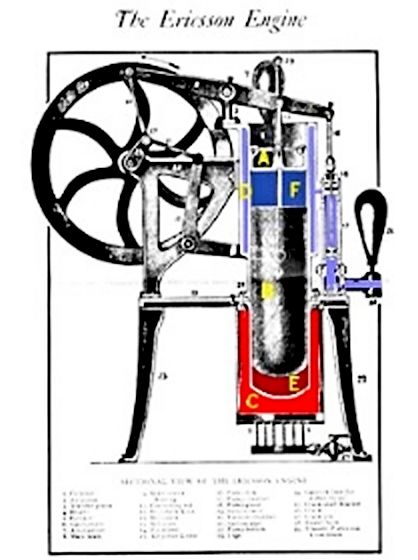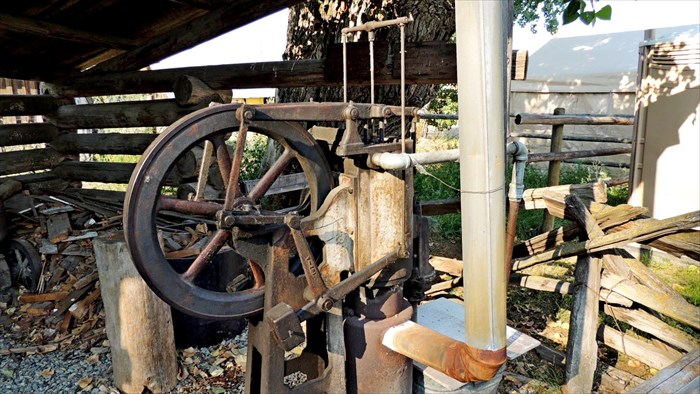|
 Ericsson Pumping Engine - Kelowna, BC Posted by:  T0SHEA T0SHEA
N 49° 50.966 W 119° 28.062
11U E 322604 N 5524810
Here is an engine that is unique in our experience. It is an Ericsson Hot Air Pumping Engine, a variation on the Stirling Engine, first envisioned in the 18th century.
Waymark Code: WMMB8A
Location: British Columbia, Canada
Date Posted: 08/25/2014
Views: 2
I'm guessing this is the first "Improved Ericsson" pumping engine to be submitted to this category. It was manufactured ca. 1900 by the American Machine Company of Newark, Delaware.
This pump is in an old shed toward the rear of Father Pandosy Mission on Benvoulin Road in Kelowna, the first white settlement in the Okanagan Valley, begun in 1859. Patented in 1895, that would make the patent on this pump just 36 years younger than its present home. The "Improved Ericsson" engine was manufactured solely for water pumping.
Hot Air Engines work on the principle of the changing volume/pressure of a mass of gas as it is heated and cooled. At the bottom of this Ericsson is a small firebox, in which (presumably) wood was burned to heat air in the cylinder, which caused it to expand, pushing on the piston connected to the pump, drawing water. At the same time a displacer is moved down, displacing the air up into a chamber which is cooled by the water being pumped, cooling the air, causing it to contract and pull the piston in the other direction, where the cycle repeats. As can be seen, some complex gearing and levers are used to accomplish all this.
![]()
Ericsson Hot Air Pumping Engine
Powering engines by the changing volume of air as it changed temperature was first envisioned by Henry Wood in his patent of 1759. His idea was to pump heated air into a large cylinder, cool the air, and let the atmosphere do the work on the inward stroke of the piston.
The first to build a working model of Wood's proposal was Sir George Cayley in 1807. An improved design by Cayley was produced by the Caloric Engine Company in England and the Roper Caloric Engine Company in the United States. Further technological advancements by the Rev. Robert Stirling in 1816 earned him a spot in history as the "inventor" of the hot air or "Stirling" engine.
John Ericsson, builder of the ironclad U.S.S. Monitor, developed many different hot air engine designs, beginning with his 1826 British Patent.
Ericsson engines were used strictly to pump water; the smaller engines such as ours were used in homes and small businesses. The water was pumped from a well or cistern into an overhead tank where it was stored for later usage.
The operation of the stirling engine is not complicated. There are no carburetors, ignition systems, valves, or other complicated mechanisms. Stirling engines run off of the expansion of air as it is heated, and the contraction of the same air as it is cooled. The source of heat can be wood, fuel oil, sunlight, or geothermal sources. Cooling can be achieved from water, air, or even ice cubes!
In the colored diagram below, "A" is the power piston; it moves up as the air in the cylinder is heated, and moves down when the air is cooled. The diameter of the piston is 6 inches and the stroke is 2 7/8 inches. "B" is the displacer; it is about 1/4 inch smaller than the diameter of the cylinder. The displacer moves the air from the hot side of the cylinder to the cold side and vice versa, but more on that later. "C" is the firebox where wood, natural gas, or other fuels are burned. "D" is the water jacket. Water that is being pumped by the engine is first sent into the water jacket to provide cooling.
The cycle of the Ericsson engine are as follows: Air at the bottom of the cylinder (E) is heated, thus expanding and forcing the piston (A) upward. At this time the displacer (B) is driven downward to the bottom of the cylinder. Since the displacer is of a smaller diameter than the cylinder, the hot air rushes around the displacer to the cool end of the engine (F). Once in the top end of the cylinder, the hot air begins to contract, sucking the piston downward. Now the displacer moves upward, forcing all the cool air from the top end of the cylinder into the bottom end. Here the air is heated and the cycle begins again.
From Rusty Iron![]()


Type of Machine: Hot Air Engine

Year the machine was built: ca 1900

Year the machine was put on display: ca 1980

Is there online documentation for this machine: Not listed

|
Visit Instructions:
To log a visit, please post a photo of the location you took yourself. You do not have to be in the picture, neither your GPSr. If you cannot provide a photo your visit will still be welcome, but then you have to tell us a bit more about your visit.
Recent Visits/Logs:
| There are no logs for this waymark yet. |
|
|
|
|